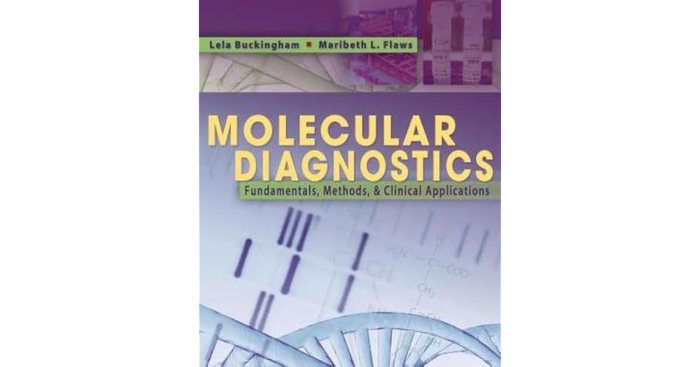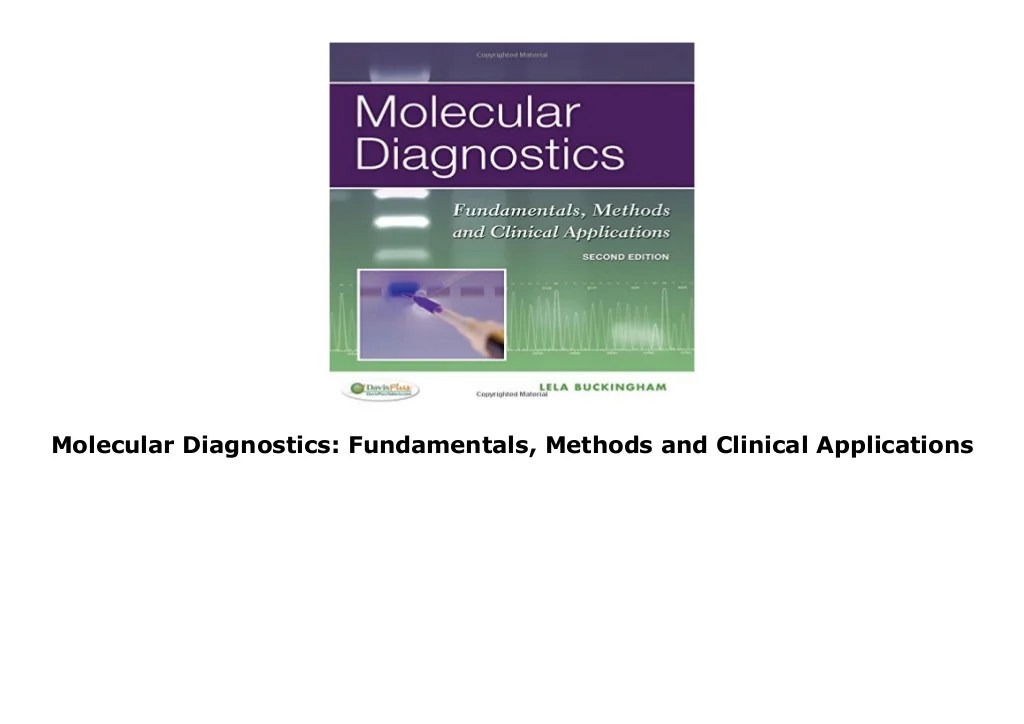Molecular diagnostics fundamentals methods and clinical applications – Molecular diagnostics, a rapidly evolving field, utilizes advanced techniques to analyze biological molecules for disease diagnosis, prognosis, and treatment monitoring. This comprehensive guide delves into the fundamentals, methods, and clinical applications of molecular diagnostics, providing a comprehensive overview of this transformative technology.
Molecular diagnostics has revolutionized healthcare, enabling personalized medicine, improved disease management, and the development of novel therapies. By understanding the principles and applications of molecular diagnostics, healthcare professionals can harness its power to improve patient outcomes and advance the field of medicine.
Fundamentals of Molecular Diagnostics: Molecular Diagnostics Fundamentals Methods And Clinical Applications

Molecular diagnostics involves the analysis of nucleic acids (DNA and RNA) to detect and characterize genetic variations, gene expression levels, and other molecular markers associated with disease. The basic principles and techniques used in molecular diagnostics include:
- Nucleic acid extraction: Isolating DNA or RNA from clinical samples, such as blood, tissue, or saliva.
- Amplification: Using techniques like polymerase chain reaction (PCR) to make millions of copies of the target nucleic acid sequence.
- Detection: Employing methods such as gel electrophoresis, real-time PCR (qPCR), or sequencing to identify and analyze the amplified DNA or RNA.
Molecular diagnostic platforms include:
- Microarrays: DNA chips that allow for the simultaneous analysis of multiple genes or genetic variations.
- Next-generation sequencing (NGS): High-throughput sequencing technologies that provide comprehensive genomic information.
- Biosensors: Devices that detect and quantify specific nucleic acid sequences or biomarkers.
Methods in Molecular Diagnostics

Various methods are used for DNA and RNA analysis in molecular diagnostics:
Polymerase Chain Reaction (PCR)
PCR is a technique that amplifies a specific DNA sequence by repeated cycles of heating and cooling. It involves three main steps: denaturation, annealing, and extension.
Quantitative PCR (qPCR)
qPCR is a variation of PCR that measures the amount of DNA or RNA in a sample. It uses fluorescent probes to detect the amplified DNA in real-time.
DNA Sequencing
DNA sequencing determines the order of nucleotides in a DNA molecule. It provides information about genetic variations, gene mutations, and other genomic alterations.
| Method | Sensitivity | Specificity | Cost |
|---|---|---|---|
| PCR | High | Moderate | Low |
| qPCR | Very high | High | Moderate |
| DNA Sequencing | Low | Very high | High |
Clinical Applications of Molecular Diagnostics

Molecular diagnostics plays a crucial role in disease diagnosis, prognosis, and treatment monitoring:
Disease Diagnosis
- Infectious diseases: Detecting the presence of pathogenic microorganisms (e.g., bacteria, viruses, fungi).
- Genetic disorders: Identifying genetic mutations or variations associated with inherited diseases (e.g., cystic fibrosis, sickle cell anemia).
- Cancer: Identifying specific genetic alterations or biomarkers that indicate the presence or type of cancer.
Prognosis, Molecular diagnostics fundamentals methods and clinical applications
- Predicting disease progression: Assessing the risk of disease recurrence or metastasis based on molecular markers.
- Determining treatment response: Identifying patients who are more likely to respond to specific therapies based on their molecular profile.
Treatment Monitoring
- Monitoring treatment effectiveness: Evaluating the response to therapy and adjusting treatment plans accordingly.
- Detecting drug resistance: Identifying genetic mutations that confer resistance to certain drugs.
Future Directions in Molecular Diagnostics

Molecular diagnostics is continuously evolving, with emerging trends and advancements:
Personalized Medicine
- Tailoring treatments: Using molecular information to develop personalized treatment plans based on an individual’s genetic profile.
- Predicting disease risk: Identifying individuals at high risk for developing certain diseases based on their genetic makeup.
Disease Prevention
- Early detection: Developing molecular tests for early detection of diseases, even before symptoms appear.
- Preventive measures: Identifying genetic markers that increase susceptibility to certain diseases, allowing for preventive measures to be taken.
Molecular diagnostics holds immense potential for transforming healthcare, improving patient outcomes, and advancing our understanding of human health and disease.
Commonly Asked Questions
What are the key principles of molecular diagnostics?
Molecular diagnostics relies on analyzing biological molecules, such as DNA and RNA, to identify genetic variations, mutations, and other molecular markers associated with disease.
What are the different methods used in molecular diagnostics?
Common methods include PCR (polymerase chain reaction), qPCR (quantitative PCR), and sequencing, each with its advantages and disadvantages for specific applications.
How is molecular diagnostics used in clinical practice?
Molecular diagnostics plays a crucial role in disease diagnosis, prognosis, and treatment monitoring, enabling personalized medicine and improved patient outcomes.
What are the ethical and regulatory considerations associated with molecular diagnostics?
Ethical and regulatory frameworks are essential to ensure the responsible use of molecular diagnostics, addressing issues such as privacy, data sharing, and potential biases.
What is the future of molecular diagnostics?
Molecular diagnostics is rapidly evolving, with advancements in technologies such as next-generation sequencing and the integration of artificial intelligence, promising even greater precision and personalized healthcare.